6 Limits
LIMITS
By the end of this chapter, the student should be able to:
- Describe the basic concept of a limit
- Explain the three methods for evaluating a limit
- Determine the best method for evaluating the value of a limit
- Explain what a one-sided limit is
- Assess how to evaluate a one-sided limit
THE LIMIT OF A FUNCTION
The Idea, Informally
Calculus has been called the study of continuous change, and the limit is the basic concept which allows us to describe and analyze such change. An understanding of limits is necessary to understand derivatives, integrals and other fundamental topics of calculus.
The limit of a function describes the behavior of the function when the variable is near, but does not equal , a specified number (Fig. 1). If the values of f(x) get closer and closer , as close as we want, to one number L as we take values of x very close to (but not equal to) a number c, then we
say “the limit of f(x), as x approaches c, is L ” and we
write “![]() “
“
(The symbol ” ->” means “approaches” or “gets very close to.”)
![]() is a single number that describes the behavior of f NEAR, BUT NOT AT, the point x = c.
is a single number that describes the behavior of f NEAR, BUT NOT AT, the point x = c.
If we have a graph of the function near x = c , then it is usually easy to determine f(x) .
Example 1: Use the graph of y = f(x) in Fig. 2 to determine the following limits:
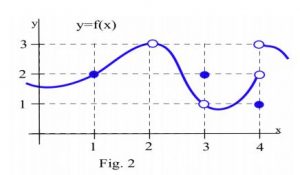
(a) ![]() (b)
(b) ![]()
(c) ![]() (d)
(d) ![]()
Solution:
(a) f(x) = 2 . When x is very close to 1, the values of f(x) are very close to y = 2. In this example, it happens that f(1) = 2, but that is irrelevant for the limit. The only thing that matters is what happens for x close to 1 but x ≠ 1.
(b) f(2) is undefined, but we only care about the behavior of f(x) for x close to 2 and not equal to 2. When x is close to 2, the values of f(x) are close to 3. If we restrict x close enough to 2, the values of y will be as close to 3 as we want, so f(x) = 3.
(c) When x is close to 3 (or as x approaches the value 3), the values of f(x) are close to 1 (or approach the value 1), so f(x) = 1. For this limit it is completely irrelevant that f(3) = 2, We only care about what happens to f(x) for x close to and not equal to 3.
(d) This one is harder and we need to be careful. When x is close to 4 and slightly less than 4 (x is just to the left of 4 on the x–axis), then the values of f(x) are close to 2. But if x is close to 4 and slightly larger than 4 then the values of f(x) are close to 3. If we only know that x is very close to 4, then we cannot say whether y = f(x) will be close to 2 or close to 3 –– it depends on whether x is on the right or the left side of 4. In this situation, the f(x) values are not close to a single number so we say f(x) does not exist. It is irrelevant that f(4) = 1. The limit, as x approaches 4, would still be undefined if f(4) was 3 or 2 or anything else.
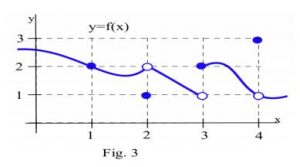
Practice 1: Use the graph of y = f(x) in Fig. 3 to determine the following limits:
(a) ![]() (b)
(b) ![]()
(c) ![]() (d)
(d) ![]()
Example 2: Determine the value of ![]()
Solution: We need to investigate the values of f(x) when x is close to 3. If the f(x) values get
arbitrarily close to or even equal some number L, then L will be the limit. One way to keep track of both
the x and the f(x) values is to set up a table and to pick several x values which are closer and closer (but
not equal) to 3. We can pick some values of x which approach 3 from the left, say x = 2.91, 2.9997,
2.999993, and 2.9999999 , and some values of x which approach 3 from the right, say x = 3.1, 3.004,
3.0001, and 3.000002 . The only thing important about these particular values for x is that they get closer and closer to 3 without equaling 3. You should try some other values “close to 3” to see what happens. Our table of values is:
| x | f(x) |
| 2.9 | 6.82 |
| 2.9997 | 6.994 |
| 2.999993 | 6.999986 |
| 2.9999999 | 6.9999998 |
| 2.9 -> 3 | 6.82 -> 7 |
| 3.1 | 7.2 |
| 3.004 | 7.008 |
| 3.0001 | 7.0002 |
| 3.000002 | 7.000004 |
| 3.1 -> 3 | 7.2 -> 7 |
As the x values get closer and closer to 3, the f(x) values are getting closer and closer to 7. In
fact, we can get f(x) as close to 7 as we want (“arbitrarily close”) by taking the values of x very
close (“sufficiently close”) to 3.
![]() = 7
= 7
Instead of using a table of values , we could have graphed y = f(x) for x close to 3 , Fig. 4, and used the graph to answer the limit question. This graphic approach is easier, particularly if you have a calculator or computer do the graphing work for you, but it is really very similar to the “table of values” method: in each case you need to evaluate y = f(x) at many values of x near 3.
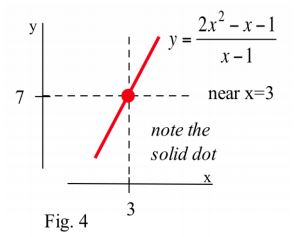
The next example illustrates the difficulty.
Example 3: Determine the value of ![]()
(Same as Example 2 but with x→1.)
You might try to evaluate ![]() at x= 1 but f is not defined at x = 1. It is tempting, but wrong, to conclude that this function does not have a limit as x approaches 1.
at x= 1 but f is not defined at x = 1. It is tempting, but wrong, to conclude that this function does not have a limit as x approaches 1.
Table Method: Trying some “test” values for x which get closer and closer to 1 from both the left and the right, we get:
| x | f(x) |
| 0.9 | 2.82 |
| 0.9998 | 2.996 |
| 0.999994 | 2.999988 |
| 0.9999999 | 2.9999998 |
| 1 -> 3 | 2.82 -> 3 |
| 1.1 | 3.2 |
| 1.003 | 3.006 |
| 1.0001 | 3.0002 |
| 1.000007 | 3.0000014 |
| 3.1 -> 3 | 3.2 -> 3 |
The function f is not defined at x = 1, but when x is close to 1, the values of f(x) are getting very close to 3.
We can get f(x) as close to 3 as we want by taking x very close to 1 so ![]() .
.
Graph Method: We can graph y = f(x) = ![]() for x close to 1, Fig. 5, and notice that whenever x is close to 1, the values of y = f(x) are close to 3. f is not defined at x = 1, so the graph has
for x close to 1, Fig. 5, and notice that whenever x is close to 1, the values of y = f(x) are close to 3. f is not defined at x = 1, so the graph has
a hole above x = 1, but we only care about what f(x) is doing for x close to but not equal to 1.
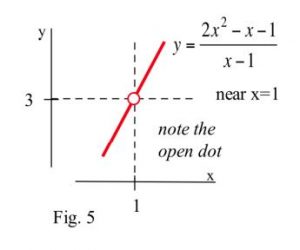
Algebra Method: We could have found the same result by noting that ![]() as long as x ≠ 1. (If x≠1, then x–1 ≠ 0 so it is valid to divide the numerator and denominator by the factor x–1.) The “x→1” part of the limit means that x is close to 1 but not equal to 1,
as long as x ≠ 1. (If x≠1, then x–1 ≠ 0 so it is valid to divide the numerator and denominator by the factor x–1.) The “x→1” part of the limit means that x is close to 1 but not equal to 1,
so our division step is valid and ![]() .
.
Three Methods For Evaluating Limits
The Algebra Method
The algebra method involves algebraically simplifying the function before trying to evaluate its limit.
Often, this simplification just means factoring and dividing, but sometimes more complicated algebraic or even trigonometric steps are needed.
The Table and Graph Methods
To evaluate a limit of a function f(x) as x approaches c, the table method involves calculating the values of
f(x) for “enough” values of x very close to c so that we can “confidently” determine which value f(x) is approaching. If f(x) is well–behaved, we may not need to use very many values for x. However, this method is usually used with complicated functions, and then we need to evaluate f(x) for lots of values of x.
A computer or calculator can often make the function evaluations easier, but their calculations are subject to “round off” errors. The result of any computer calculation which involves both large and small numbers should be viewed with some suspicion. For example, the function
![]() for every value of x , and my calculator gives the correct answer for some values of x :
for every value of x , and my calculator gives the correct answer for some values of x : ![]() , and f(8) and f(9) both equal 1.
, and f(8) and f(9) both equal 1.
But my calculator says ![]() so it evaluates f(10) to be 0, definitely an incorrect value. Your calculator may evaluate f(10) correctly, but try f(35) or f(107).
so it evaluates f(10) to be 0, definitely an incorrect value. Your calculator may evaluate f(10) correctly, but try f(35) or f(107).
Calculators are too handy to be ignored, but they are too prone
to these types of errors to be believed uncritically. Be careful.
The graph method is closely related to the table method, but we create a graph of the function instead of a table of values, and then we use the graph to determine which value f(x) is approaching.
Which Method Should You Use?
In general, the algebraic method is preferred because it is precise and does not depend on which values of x we chose or the accuracy of our graph or precision of our calculator. If you can evaluate a limit algebraically, you should do so. Sometimes, however, it will be very difficult to evaluate a limit algebraically, and the table or graph methods offer worthwhile alternatives. Even when you can algebraically evaluate the limit of a function, it is still a good idea to graph the function or evaluate it at a few points just to verify your algebraic answer.
The table and graph methods have the same advantages and disadvantages. Both can be used on very complicated functions which are difficult to handle algebraically or whose algebraic properties you don’t know. Often both methods can be easily programmed on a calculator or computer. However, these two methods are very time–consuming by hand and are prone to round off errors on computers. You need to know how to use these methods when you can’t figure out how to use the algebraic method, but you need to use these two methods warily.
Example 4:
Evaluate:
(a) ![]()
(b) ![]()
Solution: The function in each limit is the same but x is approaching a different number in each of them. (a) Since x→0, we know that x is getting closer and closer to 0 so the values of the ![]() , 5x and 3x terms get as close to 0 as we want. The numerator approaches 6 and the denominator approaches 2, so the values of the whole function get arbitrarily close to 6/2 = 3, the limit.
, 5x and 3x terms get as close to 0 as we want. The numerator approaches 6 and the denominator approaches 2, so the values of the whole function get arbitrarily close to 6/2 = 3, the limit.
(b) As x approaches –2, the numerator and denominator approach 0, and a small number divided by a
small number can be almost anything –– the ratio depends on the size of the top compared to the bottom.
More investigation is needed.
Table Method: If we pick some values of x close to (but not equal to) –2, we get the table:
| x | |||
| -1.97 | 0.0309 | -0.0291 | -1.061856 |
| -2.005 | -0.004975 | 0.005025 | -0.990050 |
| -1.9998 | 0.00020004 | -0.00019996 | -1.00040008 |
| -2.00003 | 2.9999998 | 0.0000300009 | -0.9996666 |
| -> -2 | -> 0 | -> 0 | -> -1 |
Even though the numerator and denominator are each getting closer and closer to 0, their ratio is
getting arbitrarily close to –1 which is the limit.
Graph Method: The graph of ![]() in Fig. 6 shows that the values of f(x) are very close to –1 when the x–values are close to –2.
in Fig. 6 shows that the values of f(x) are very close to –1 when the x–values are close to –2.
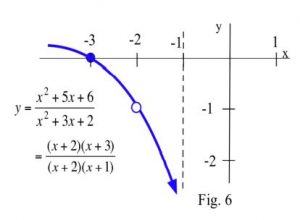
Algebra Method: ![]() .
.
We know x → –2 so x ≠ –2, and we can divide the top and bottom by (x+2). Then f(x) = (x+3)/(x+1) so
f(x) → 1/–1 = –1 as x → –2.
(b) ![]()
close to 3 and x < 3), then the values of [x] = INT(x) equal 2 (Fig. 7). If we let x approach 3 from the right (x is close to 3 and x > 3), then the values of [x] = INT(x) equal 3. On the number line we can approach a point from the left or right, and that leads to one–sided limits.
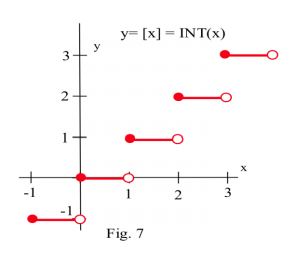
Definition of Left and Right Limits:
The left limit as x approaches c of f(x) is L if the values of f(x) get as close to L as we want when x is very close to and left of c, x < c:
![]()
The right limit, written with x → c+ , requires that x lie to the right of c, x > c
Example 5:
Evaluate ![]() and
and ![]()
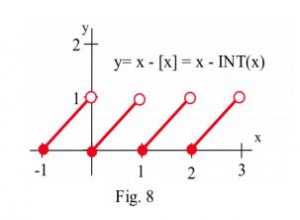
The left–limit notation x → 2– requires that x be close to 2 and that x be to the left of 2, so x < 2.
If 1 < x < 2, then [x] = 1 so ![]()
If x is close to 2 and is to the right of 2, then 2< x < 3 so [x] = 2 and ![]()
If the left and right limits have the same value, ![]() , then the value of f(x) is close to L whenever x is close to c, and it does not matter if x is left or right of c so
, then the value of f(x) is close to L whenever x is close to c, and it does not matter if x is left or right of c so ![]() . Similarly, if
. Similarly, if ![]() , then f(x) is close to L whenever x is close to c and less than c and whenever x is close to c and greater than c, so
, then f(x) is close to L whenever x is close to c and less than c and whenever x is close to c and greater than c, so ![]() . We can combine these two statements into a single theorem.
. We can combine these two statements into a single theorem.
One–Sided Limit Theorem:
![]() if and only if
if and only if ![]()
Corollary:
If ![]() does not exist
does not exist
Media Attributions
- Fig2Limits
- Fig3Limits
- Fig4Limits
- Fig5Limits
- Fig6Limits
- Fig7Limits
- Fig8Limits

